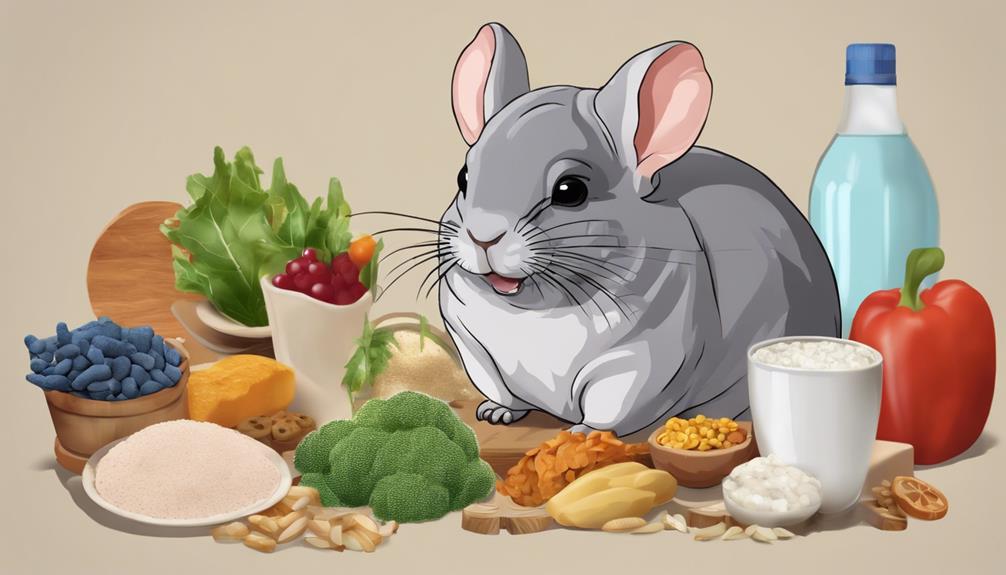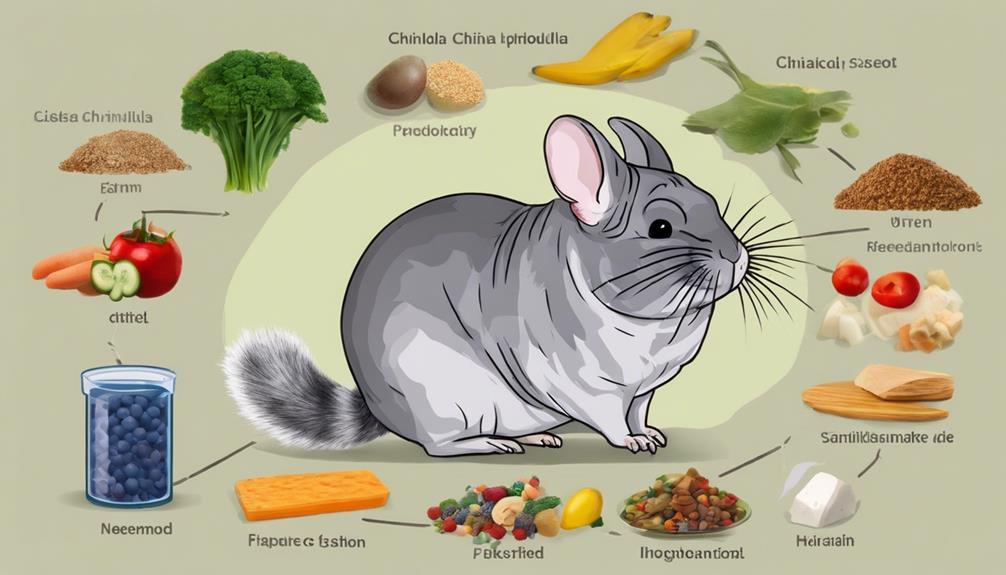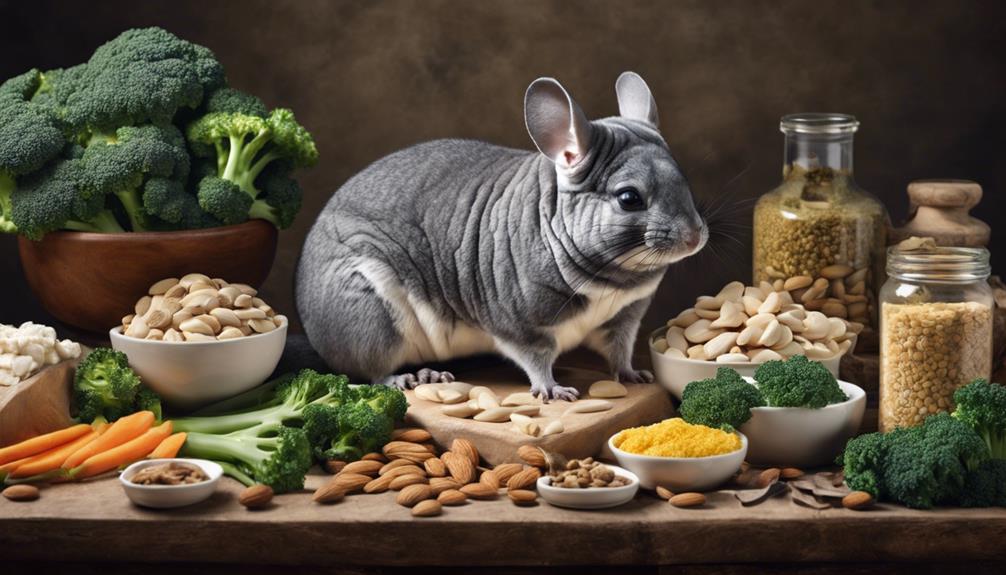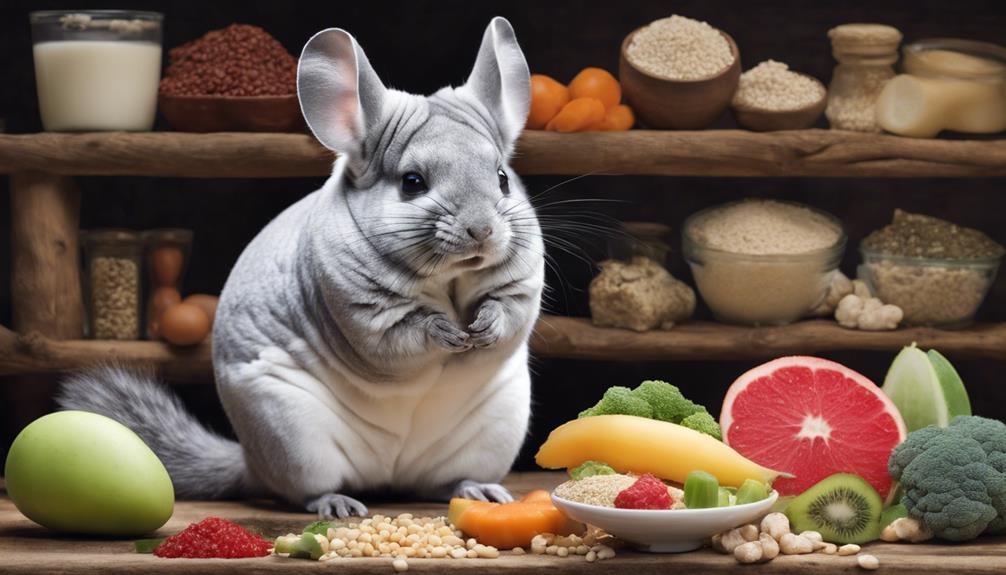Why Calcium to Phosphorus Ratio Is Crucial in Chinchilla Diets

Calcium and phosphorus are essential minerals required for the proper growth and maintenance of chinchillas.
However, the ratio of calcium to phosphorus is critical in maintaining their overall health.
A balanced ratio of these minerals is necessary to prevent various health issues such as bladder stones and metabolic bone disease.
Ensuring the correct calcium to phosphorus ratio in chinchilla diets is key to promoting their well-being and longevity.
Importance of Calcium to Phosphorus Ratio
Understanding the significance of the calcium to phosphorus ratio in chinchilla diets is imperative for maintaining their overall health and well-being. Chinchillas have specific nutritional requirements that must be met to guarantee they thrive in captivity. One of the key aspects of meeting these requirements is maintaining the proper dietary balance, particularly when it comes to the calcium to phosphorus ratio.
Calcium and phosphorus play vital roles in a chinchilla's diet, impacting their bone health, teeth strength, and overall bodily functions. A proper balance between these two minerals is essential for preventing deficiencies or imbalances that could lead to serious health issues. Without the correct ratio, chinchillas may experience problems such as weakened bones, dental abnormalities, and metabolic disorders.
Health Implications of Imbalance
An imbalance in the calcium to phosphorus ratio in chinchilla diets can have detrimental effects on their bone density and overall metabolic function. Ensuring the right balance is essential for the well-being of these adorable creatures. Here are some insights into the health implications of such an imbalance:
- Long term consequences: Over time, an improper ratio can lead to weakened bones, fractures, and even skeletal deformities in chinchillas.
- Preventive measures: Regularly monitoring and adjusting the calcium to phosphorus ratio in their diet can help prevent these severe health issues.
- Nutritional supplements: Providing chinchillas with appropriate calcium and phosphorus supplements can aid in maintaining the right balance for their dietary needs.
- Veterinary guidance: Consulting a veterinarian experienced in chinchilla care is vital for tailored advice on diet, supplements, and overall health management.
Common Causes of Imbalance

You must pay close attention to the diet composition of your chinchilla to ensure a proper calcium to phosphorus ratio. Imbalance in these essential minerals can lead to severe health implications for your furry friend.
Diet Composition Importance
To maintain ideal health for your chinchilla, careful attention to the balance of calcium to phosphorus ratio in their diet is essential, as imbalances can lead to various health issues. When considering the diet composition for your chinchilla, there are common causes of imbalance that you should be aware of:
- High Calcium Foods: Excessive consumption of calcium-rich foods can disrupt the calcium-phosphorus ratio.
- Phosphorus Deficiency: Inadequate phosphorus intake can also affect the overall balance.
- Inappropriate Supplements: Incorrect use of supplements can throw off the mineral intake.
- Poor Quality Feed: Low-quality feed may not provide the necessary nutrients, impacting your chinchilla's health.
Health Implications of Imbalance
What're the potential health risks associated with imbalanced calcium to phosphorus ratios in chinchilla diets?
Imbalances in these essential minerals can lead to severe nutritional consequences and impact bone health and digestion.
When calcium and phosphorus aren't properly balanced, chinchillas may experience issues such as weakened bones, dental problems, and poor nutrient absorption.
To manage this, make sure chinchillas are fed a diet that maintains the ideal ratio of calcium to phosphorus.
Implementing a balanced diet rich in hay, pellets, and limited treats can help prevent these imbalances and promote overall health.
Monitoring the calcium to phosphorus ratio is critical for chinchilla owners to make sure their pets lead healthy and happy lives.
Symptoms of Ratio Imbalance
You must pay close attention to warning signs of imbalance in the calcium to phosphorus ratio in your chinchilla's diet. Neglecting these signs can lead to serious health risks for your furry friend.
Being proactive and observant is key to ensuring your chinchilla maintains peak health.
Warning Signs of Imbalance
An imbalance in the calcium to phosphorus ratio can manifest through various warning signs, indicating a potential issue in chinchilla diets. To recognize signs early and prevent issues, keep an eye out for the following symptoms:
- Loss of Appetite: Chinchillas may show disinterest in their food.
- Weight Loss: Sudden or unexplained weight loss could be a red flag.
- Weakness or Lethargy: Reduced activity levels or sluggish behavior may indicate an imbalance.
- Bone Issues: Fractures or dental problems could be linked to an incorrect ratio.
Health Risks Associated
A proper balance between calcium and phosphorus in chinchilla diets is crucial to ward off potential health risks associated with an imbalance in this ratio. When the calcium to phosphorus ratio is skewed, chinchillas may experience various symptoms signaling underlying issues.
Prevention strategies involve carefully selecting feed with the correct ratio and guaranteeing a balanced diet. If left unaddressed, long-term consequences of an imbalanced ratio can lead to serious health concerns.
Effective management includes adjusting the diet, providing supplements if necessary, and consulting a veterinarian for tailored advice. Treatment may involve correcting the ratio through diet modifications and monitoring the chinchilla's health closely. By understanding the health risks associated with an imbalance in calcium to phosphorus ratio, you can take proactive steps to assure your chinchilla's well-being.
Tips for Balancing Chinchilla Diets

To effectively balance chinchilla diets, focus on adjusting the calcium to phosphorus ratio in their food intake. Chinchillas require a specific balance of these minerals to maintain peak health. Here are some tips to help you make sure your chinchilla's diet is well-balanced:
- Supplement Options: Consider incorporating chinchilla-specific supplements to meet their nutritional needs and support overall well-being.
- Monitor Mineral Balance: Keep track of the calcium to phosphorus ratio in your chinchilla's diet to prevent any imbalances that could lead to health issues.
- Consult a Veterinarian: If you're unsure about the right dietary adjustments for your chinchilla, seek advice from a veterinarian specializing in exotic pets.
- Provide Variety: Offer a diverse range of chinchilla-safe foods to make certain they receive a broad spectrum of nutrients essential for their health.
Best Food Sources for Ratio
For a well-rounded chinchilla diet that optimizes the calcium to phosphorus ratio, explore the best food sources to guarantee your furry friend's nutritional needs are met appropriately.
When considering natural sources, hay is a staple for chinchillas, providing essential fiber and aiding in wearing down their teeth. Timothy hay is an excellent choice due to its ideal calcium to phosphorus ratio.
Additionally, dark leafy greens like kale, spinach, and broccoli offer a good balance of these minerals. Pellets formulated specifically for chinchillas can also be a reliable source, but be sure to check the ingredient list to make sure the ratio is appropriate.
For supplement options, calcium blocks or cuttlebones can be provided in moderation to help meet their calcium needs. However, it's important not to overdo it with supplements, as an imbalance can be detrimental to your chinchilla's health.
Monitoring and Adjusting Ratios

Keep a close eye on the calcium to phosphorus ratio in your chinchilla's diet to guarantee peak health and well-being. Ensuring the right balance is vital for your furry friend's overall health.
Here's how you can monitor and adjust the ratios effectively:
- Regular Check-Ups: Schedule routine veterinary visits to monitor your chinchilla's health and discuss any dietary adjustments needed.
- Balanced Diet: Offer a variety of chinchilla-safe foods to maintain the correct calcium to phosphorus ratio naturally.
- Nutritional Supplements: Consider incorporating vet-approved supplements to support your chinchilla's dietary needs.
- Monitoring Progress: Keep track of your chinchilla's weight, behavior, and overall well-being to assess the effectiveness of dietary changes.
Frequently Asked Questions
Can Chinchillas Consume Too Much Calcium or Phosphorus, and What Are the Risks Associated With Overconsumption?
Consuming excessive calcium or phosphorus can lead to health complications for chinchillas. It's important to maintain a proper dietary balance to meet their nutritional needs. Overconsumption may result in various issues, so be mindful of their intake levels.
How Does the Calcium to Phosphorus Ratio in Chinchilla Diets Affect Their Dental Health?
Maintaining proper dietary balance is important for chinchilla dental health. The calcium to phosphorus ratio in their diets directly impacts tooth strength and gum health. Ensuring this balance promotes overall well-being and prevents potential dental issues.
Are There Any Specific Chinchilla Breeds or Age Groups That Require a Different Calcium to Phosphorus Ratio in Their Diets?
In the world of chinchilla breeds, remember that different furballs have varying dietary needs. Similarly, age groups, with their unique nutritional requirements, may call for tailored calcium to phosphorus ratios to keep them thriving healthily.
Can Environmental Factors, Such as Temperature or Humidity, Impact the Calcium to Phosphorus Ratio in Chinchilla Diets?
Temperature fluctuations in chinchilla habitats can affect nutrient absorption, impacting the calcium to phosphorus ratio in their diets. Maintaining a proper dietary balance is vital. Similarly, humidity levels play a role in ensuring chinchillas receive essential nutrients.
Are There Any Supplements or Alternative Food Sources That Can Help Chinchilla Owners Maintain the Proper Calcium to Phosphorus Ratio in Their Pet's Diet?
Looking to maintain the right nutritional balance for your chinchilla? Supplement options like hay-based pellets, fresh hay, and leafy greens can assist. Guarantee your pet's health by providing a varied diet rich in essential nutrients.











